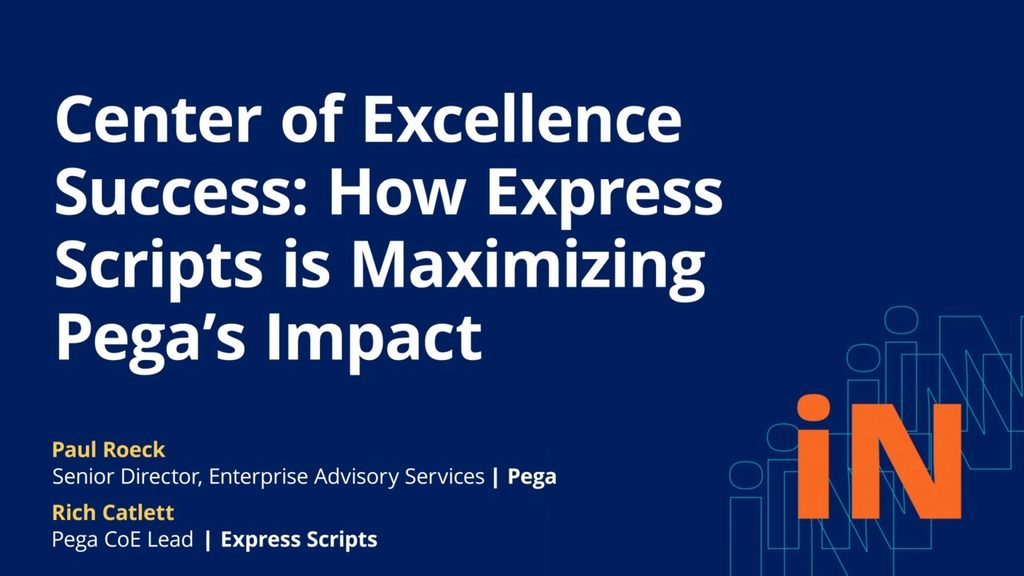
Pega Center of Excellence
Together we make digital transformation real.
What is a COE?
A Pega Center of Excellence (COE) is a team of Pega experts that works cross functionally across your enterprise to provide leadership, support, and guidance for transformational initiatives that use Pega technology. A Pega COE can help you accelerate time to value, drive out delivery program costs, and maximize ROI for your Pega investment.

COE Success: How Express Scripts is Maximizing Pega’s Impact
Hear from Rich Catlett, Pega COE Lead at Express Scripts, as he explains the value that the COE brings to his organization.
Defining scope and roadmap
Establishing a COE is not a one-size-fits-all endeavor. The structure and model depends on your Pega maturity, your organizational structure, your mix of Pega and other automation tools, and so on. Pega recommends taking an incremental approach to establishing your COE, focusing equally on three key areas: Do a few things, do them well, showcase your successes – then expand.
People
A COE is comprised of people that combine their deep knowledge in business processes, technical expertise, and software delivery methodologies with a passion for customer experience.
Process
Building a solid process foundation starts at the enterprise level, with an agile program delivery model that enables you to build the right solutions that deliver business value swiftly. Integrating experience design into that delivery model allows you to unlock great user experiences and maximize adoption.
Technology
Delivering transformation with Pega at scale requires a prescriptive set of enterprise best practices and best practices. The platform must also be available, secure, and scalable to accommodate future demand. To maximize the value of your Pega investment, COE teams showcase emerging Pega Platform™ features so you can take advantage of all that Pega offers.
Roles and responsibilities
Digital transformation – and Pega delivery success – requires explicit and active collaboration between business and IT, from executive sponsors to users. Having the right people in the following four key roles is critical:
1. Delivery leads help teams apply Pega’s tools and techniques to maximize agility at a program level, using their deep background in business process architecture and expertise with multiple agile frameworks. They help ensure that solutions are fit for purpose and maximize out-of-the-box capabilities.
2. Technical leads provide Pega-specific technical guidance, partnering with specialists throughout the enterprise to define best practices, policies, and standards that fit into your enterprise context. They help teams maximize product, application, and feature reuse to deliver solutions faster at reduced cost.
3. Experience designers orchestrate customer journeys, helping business and IT teams understand the “art of the possible” and solve business challenges in a user-centric way. They design transformational experiences up front and design solutions that users will love.
4. COE or Innovation Center managers are primarily responsible for establishing the COE, ensuring strategic alignment, and overseeing its day-to-day operations. They establish clear success metrics and continually inspect and adapt. They partner with executive sponsors, customers, and users to evangelize Pega successes across the company.
Together, the COE team works with executive leadership, enterprise communities, and delivery teams to drive business value achievement and build agility into the world's leading organizations.
Maturing a COE
Pega recommends a crawl-walk-run approach to building your capability, with metrics and scope that evolve over time. We use a customizable five-level maturity model to guide you in integrating your business processes and enterprise architecture into an executable roadmap for digital transformation.
Level 1 – Established: Organizations without a COE in place start here, with key success factors in place: clear business and IT sponsorship, four roles, clear scope, and initial success measures.
Level 2 – Enabled: The COE has identified and empowered critical roles, formalized its responsibilities, and defined the initial engagement model. The COE has established a lightweight guidance model and is prepared to execute on its initial goals.
Level 3 – Operational: The COE is executing on its initial goals and may be providing expert services to project teams. The COE maintains a robust library of best practices, coordinates reuse around shared components, and guides teams to develop high-quality solutions that perform well and are scalable. User experience is incorporated into the delivery model. The COE evaluates new opportunities for automation.
Level 4 – Expanded: The COE develops and supports critical capabilities that align with organizational priorities. The COE has expanded the menu of expert services. Delivery and technical best practices and assets are available to and used by multiple line of businesses. Business outcomes and successes are reported, including financial results.
Level 5 – Enterprise-focused: A continuous improvement program is in place. Clear ROI from reuse is achieved and the delivery ecosystem is optimized. The COE is actively partnering with the business to evangelize solutions across the enterprise, sharing their successes in maximizing cost savings and accelerating time to value.
Communicating value
You will want to establish clear success measures and a well-defined scope to ensure you are solving the right problems, maximizing your areas of proficiency, showcasing your successes, and addressing opportunities for improvement.
Common categories of success measures include faster time to business value delivery, reduced development costs, improved regulatory compliance, increased enablement and proficiency, best practice compliance, better user satisfaction, more strategic use of contractors, and lower platform operations and maintenance costs.
Interested in building a COE or Innovation Center? Want to learn more about what the most successful COEs and Innovation Centers have achieved? Contact your Consulting Solutions Executive.
Below are some sample KPIs that can be used to chart the success of your COE strategy:
Related resources

How COE Reduce Risk and Drive Operational Efficiency
Pega and Stratosphere Consulting share an in-depth session on how creating a Center of Excellence can help streamline your programs.
